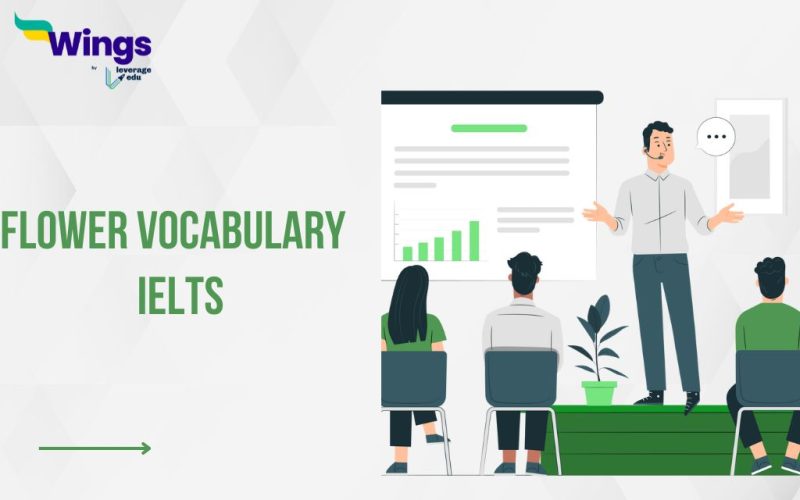Flower Vocabulary IELTS: Flower is the symbol of happiness and care. Flower is a topic which is often asked in the IELTS exam. It is one of the easiest topics which anyone can easily answer during the exam. Speaking about flowers during the IELTS exam is not a difficult task.
In the below-mentioned blog, the candidates will get to know the complete details about the list of flowers word and 100 flower vocabulary IELTS and their meanings.
List of Flowers Word
Flowers are the symbol of good luck, long life, purity and health. The students appearing for the IELTS exam must know the vocabulary which can be asked in the exam. Below is the list of words for flowers which will help them to memorise:
Here is a list of 100 flower names in alphabetical order along with their meanings, designed to help with IELTS vocabulary building. The table is organized into three columns for better readability:
| Flower Name | Meaning | Usage in IELTS Context |
| Ageratum | Long life, faithfulness | Used to describe lasting beauty in nature |
| Alstroemeria | Friendship, prosperity | Symbolic in personal growth topics |
| Amaryllis | Pride, determination | Good for self-improvement descriptions |
| Anemone | Protection, anticipation | Can be used in storytelling |
| Angelonia | Loyalty, resilience | Shows emotional strength in essays |
| Anthurium | Hospitality, abundance | Reflects warm personality in speech |
| Aster | Patience, elegance | Describes grace under pressure |
| Azalea | Passion, femininity | Adds emotion to descriptive topics |
| Begonia | Caution, deep thoughts | Useful in describing emotional situations |
| Bellflower | Gratitude, humility | Great for expressing thankfulness |
| Bird of Paradise | Joy, freedom | Reflects travel, freedom in personal stories |
| Black-eyed Susan | Encouragement, motivation | Useful in motivational speech topics |
| Bluebell | Humility, gratitude | Good for calm and peaceful descriptions |
| Bougainvillea | Passion, energy | Great in vivid setting descriptions |
| Calendula | Healing, comfort | Useful in health-related topics |
| Camellia | Admiration, perfection | Ideal in describing inspiring personalities |
| Candytuft | Sweetness, trust | Helpful in friendship contexts |
| Carnation | Love, fascination | Useful in personal relationships topics |
| Celosia | Boldness, warmth | Describes confident people or actions |
| Cherry Blossom | Renewal, beauty of life | Common in seasonal or cultural topics |
| Chrysanthemum | Loyalty, optimism | Great in family and social context |
| Clematis | Cleverness, creativity | Useful in academic and artistic topics |
| Coneflower | Strength, healing | Can relate to personal growth |
| Coreopsis | Cheerfulness, energy | Brightens descriptive language |
| Cosmos | Order, peace | Enhances ideas of harmony and nature |
| Crocus | Youth, cheerfulness | Often used in spring or childhood stories |
| Cyclamen | Farewell, resignation | Useful in parting or emotional contexts |
| Daffodil | New beginnings, hope | Ideal for career or goal-setting topics |
| Dahlia | Elegance, inner strength | Describes determined personalities |
| Daisy | Innocence, purity | Great for nature and childhood stories |
| Delphinium | Positivity, grace | Good for expressing social impressions |
| Dianthus | Boldness, admiration | Adds character to speech |
| Dogwood | Rebirth, durability | Good for resilience-based contexts |
| Edelweiss | Devotion, courage | Useful in cultural or heritage topics |
| Evening Primrose | Strength in adversity | Helpful in storytelling or challenge topics |
| Forget-Me-Not | True love, memories | Great for nostalgic IELTS parts |
| Foxglove | Intuition, creativity | Describes imaginative individuals |
| Freesia | Friendship, innocence | Useful in narrative descriptions |
| Fuchsia | Confiding love | Suitable in emotional narratives |
| Gardenia | Secret love, refinement | Ideal for romantic or elegant topics |
| Geranium | Friendship, happiness | Works in social or family-related stories |
| Gerbera Daisy | Cheerfulness, purity | Helps in expressing joyful moments |
| Gladiolus | Strength, integrity | Enhances career and personality topics |
| Globe Amaranth | Immortality, unfading love | Good in deep relationship contexts |
| Goldenrod | Encouragement, support | Motivational speech topics |
| Gypsophila | Everlasting love | Describes lasting emotions or bonds |
| Hibiscus | Delicate beauty | Describes scenery or artistic impressions |
| Hollyhock | Ambition, fertility | Good for goals and heritage |
| Honeysuckle | Generosity, devotion | Ideal in family or caregiving topics |
| Hyacinth | Sincerity, playfulness | Used in emotional or cheerful stories |
| Hydrangea | Gratitude, grace | Useful in thankfulness-related responses |
| Iris | Wisdom, courage | Works well in inspirational topics |
| Jasmine | Purity, grace | Strong in cultural and traditional topics |
| Jonquil | Desire, sympathy | Adds emotional tone to personal stories |
| Kangaroo Paw | Uniqueness, creativity | Ideal in describing special talents |
| Lantana | Rigor, transformation | Good for growth and life changes |
| Lavender | Calmness, tranquility | Great for peaceful scenery |
| Lilac | Youthful innocence | Strong for describing spring or youth |
| Lily | Purity, motherhood | Frequently used in family-related content |
| Lotus | Enlightenment, rebirth | Excellent for life lessons or values |
| Love-in-a-Mist | Confusion, charm | Interesting metaphor in stories |
| Magnolia | Dignity, perseverance | Strong for personal qualities |
| Marigold | Warmth, celebration | Useful in festivals and joyful events |
| Mimosa | Sensitivity, protection | Great in emotional conversations |
| Morning Glory | Affection, renewal | Fits well in daily routine or memories |
| Nasturtium | Patriotism, courage | Helps in cultural or patriotic topics |
| Orchid | Beauty, strength | Common in achievements and admiration |
| Pansy | Thoughtfulness | Ideal in remembering someone or reflecting |
| Passionflower | Passion, peace | Can symbolize intense emotions |
| Peony | Honor, prosperity | Great for weddings or formal events |
| Periwinkle | Peaceful memories | Often used in sentimental stories |
| Petunia | Comfort, acceptance | Suitable for emotional comfort topics |
| Phlox | Harmony, unity | Works well in community stories |
| Poinsettia | Celebration, cheer | Best for holiday or seasonal topics |
| Poppy | Remembrance, consolation | Good for history or emotional parts |
| Primrose | New beginnings | Reflects optimism and planning |
| Protea | Courage, diversity | Describes uniqueness or inclusivity |
| Queen Anne’s Lace | Sanctuary, delicacy | Great for describing gentle beauty |
| Ranunculus | Radiant charm | Ideal in love or appreciation topics |
| Rose | Love, beauty | Universally adaptable to many contexts |
| Snapdragon | Strength, grace | Describes individuals and nature |
| Snowdrop | Hope, purity | Excellent in seasonal topics |
| Star of Bethlehem | Forgiveness | Good for closure and peace |
| Statice | Sympathy, success | Emotional or motivational use |
| Sunflower | Happiness, loyalty | Bright and optimistic tone |
| Sweet Pea | Goodbye, thank you | Best for farewells or parting |
| Tansy | Health, immortality | Good in health-related IELTS topics |
| Tiger Lily | Confidence, pride | Strong for bold personalities |
| Tuberose | Pleasure, passion | Suitable in luxury or romance |
| Tulip | Perfect love | Ideal for relationships and spring |
| Verbena | Healing, creativity | Enhances emotional vocabulary |
| Violet | Loyalty, modesty | Best in character descriptions |
| Wallflower | Shyness, solitude | Can be used in emotional growth topics |
| Water Lily | Serenity, rebirth | Describes peace or personal change |
| Wisteria | Long life, devotion | Ideal for deep emotional ties |
| Yarrow | Courage, healing | Adds emotional or resilience context |
| Zinnia | Remembrance, lasting affection | Great for nostalgic IELTS parts |
Also Read: Most Popular Social Media Vocabulary IELTS
100 Flower Vocabulary Words for IELTS with their Meaning (A to Z)
Flower vocabulary is one of the easiest vocabularies asked in the IELTS exam. The students going for the IELTS exam must go through the vocabulary and their actual meaning. In the table below, the candidates will get to know about the flower vocabulary and their meanings:
| Word | Meaning |
| Aesthetic | Pleasing in appearance, often used to describe floral arrangements |
| Anther | Part of a stamen that contains pollen |
| Annual | A plant that completes its life cycle in one year |
| Aroma | A pleasant smell from flowers |
| Arrangement | A flowering shrub with colourful blooms |
| Artificial Flower | A man-made flower used for decoration |
| Autumn Crocus | A flower that blooms in fall |
| Azalea | A bell-shaped flower, often purple or blue |
| Bamboo Orchid | A tropical flower with bamboo-like stems |
| Bed | A section of a garden planted with flowers |
| Bellflower | A daisy-like flower is often used in tea |
| Blossom | A flower, especially one on a tree |
| Bloom | The state or period of flowering |
| Botanical | Related to plants and flowers |
| Bouquet | An arranged bunch of cut flowers |
| Bud | A small swelling on a plant that will become a flower |
| Bulb | A round underground part that grows into a flower |
| Calendula | Having many bright colours |
| Camellia | A winter-flowering plant with large blooms |
| Carnation | A popular flower with ruffled petals |
| Chamomile | A climbing plant with large colourful flowers |
| Chrysanthemum | A flower known for its large, decorative heads |
| Clematis | A bright yellow or orange flower is often used in healing products |
| Clove Pink | A type of carnation with a spicy scent |
| Colorful | A daisy-like flower with a raised cone centre |
| Coneflower | A daisy-like flower with a raised cone center |
| Corsage | A small bouquet worn on clothes during special occasions |
| Crocus | A small flower that blooms in early spring |
| Cultivation | The process of growing plants |
| Dahlia | A bright, bushy flower often used in shows |
| Daisy | Powder produced by flowers for fertilisation |
| Dandelion | A yellow flower that turns into a white seed puff |
| Delphinium | A tall plant with blue or purple flowers |
| Evergreen | Plants that remain green all year round |
| Fern | A green plant often used with flower arrangements |
| Foliage | Leaves of a plant or tree |
| Floral | Relating to flowers |
| Floriculture | The cultivation and management of flowers |
| Florist | A person who sells and arranges flowers |
| Flowering | The process of producing flowers |
| Fragrance | A pleasant smell from flowers |
| Gardenia | A white, scented flower often grown indoors |
| Geranium | A popular flowering plant in gardens |
| Gladiolus | A tall flower with trumpet-shaped blooms |
| Greenhouse | A structure where flowers are grown under controlled conditions |
| Hibiscus | A large, showy flower often found in tropical climates |
| Hollyhock | A tall flowering plant |
| Hyacinth | A spring flower with a sweet scent |
| Hydrangea | A bush with large clusters of flowers |
| Iris | A flower with large petals often in purple or yellow |
| Jasmine | A white flower with a strong sweet fragrance |
| Lavender | A purple flower known for its calming scent |
| Leaf | The part of a plant that is usually green |
| Lily | A large, showy flower often used in weddings |
| Lotus | A water flower with spiritual significance in many cultures |
| Magnolia | A tree or shrub with large, fragrant flowers |
| Marigold | A bright orange or yellow flower often used in decorations |
| Morning Glory | A climbing plant with trumpet-shaped flowers |
| Narcissus | Another name for daffodil |
| Orchid | An exotic flower known for its delicate beauty |
| Pansy | Another name for a daffodil |
| Peony | A large, soft-petaled flower often pink or white |
| Perennial | A plant that lives and blooms for more than two years |
| Petal | A small, clustered flower found in gardens |
| Phlox | A colourful flower with face-like markings |
| Pollen | A part of the flower, usually colourful, that surrounds the reproductive parts |
| Pollination | The process by which pollen is transferred |
| Poppy | A flower with delicate petals, often red |
| Potpourri | A mix of dried flowers used for fragrance |
| Primrose | A pale yellow flower that blooms in spring |
| Ranunculus | A rose-like flower with layered petals |
| Rhododendron | A large shrub with bright clusters of flowers |
| Rose | A classic flower with layers of petals and a sweet scent |
| Rosemary | An herb that also has small flowers |
| Saffron | A purple flower whose stigmas are used as a spice |
| Sakura | Japanese cherry blossom |
| Scents | Smells, especially pleasant ones from flowers |
| Season | The time of year when certain flowers bloom |
| Seedling | A young plant growing from a seed |
| Shrub | A small bush, often bearing flowers |
| Snapdragon | A flower with a shape like a dragon’s mouth |
| Snowdrop | A small white flower that blooms in winter |
| Soil | The material in which flowers are planted |
| Stamen | The male part of the flower that produces pollen |
| Stem | The part that supports the flower |
| Sunflower | A tall flower with a large yellow head |
| Sweet Pea | A flower with a sweet fragrance and delicate petals |
| Tuberose | A white, fragrant flower used in perfumes |
| Tulip | A spring flower with smooth, oval petals |
| Vanilla Orchid | The flower that produces vanilla pods |
| Organised display of flowers in bouquets or vases | A container for displaying cut flowers |
| Vervain | A flowering plant used in traditional medicine |
| Vinca | A small, colorful ground-cover flower |
| Violet | A small purple flower with a sweet scent |
| Water Lily | A flower that floats on water |
| Wildflower | A naturally growing flower |
| Wisteria | A small, colourful ground-cover flower |
| Yarrow | A flower with tiny white or pink clusters |
| Zinnia | A bright, daisy-like flower perfect for gardens |
Also Read: Words Related to Food Vocabulary IELTS
FAQs
The vocabulary for the flowers asked during the IELTS exam are averse, fanatic, florist, allergy, potted plants, few and far between and aesthetic.
The list of flower words is sunflower, rose, tulip, lily, orchid, daisy and poppy.
Consider taking an IELTS Mock Test to evaluate your progress or join our offline or online IELTS classes at Leverage Edu. Enhance your skills, boost your confidence, and ensure you are fully prepared for your IELTS and one step closer to achieving your study abroad aspirations.
 One app for all your study abroad needs
One app for all your study abroad needs















 60,000+ students trusted us with their dreams. Take the first step today!
60,000+ students trusted us with their dreams. Take the first step today!